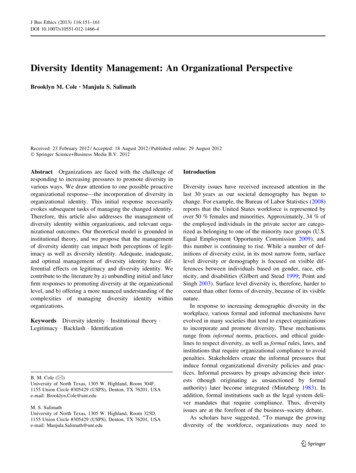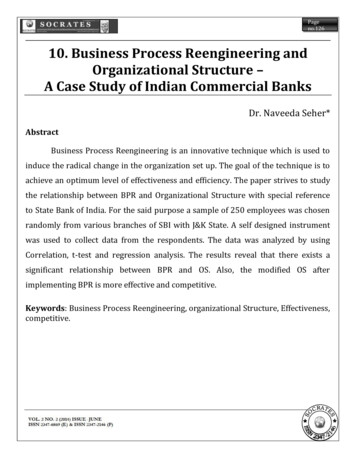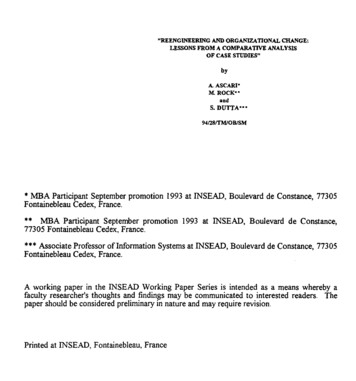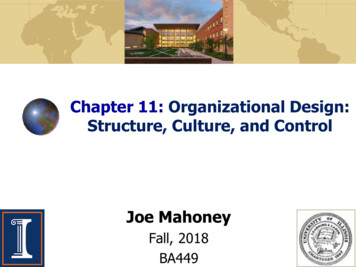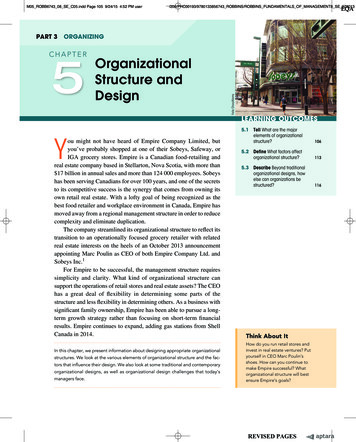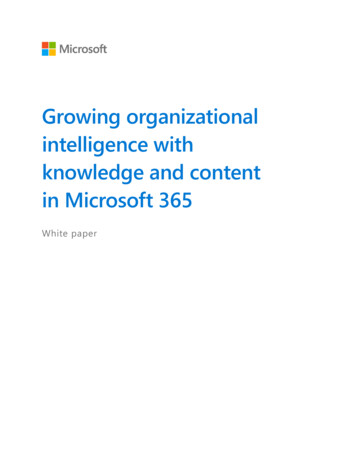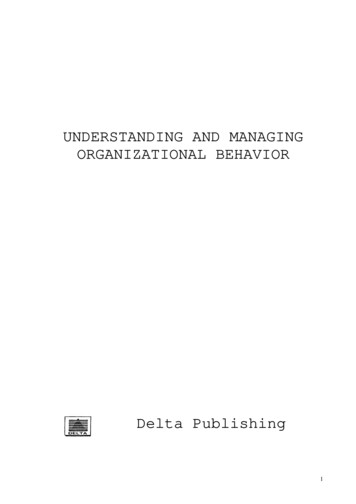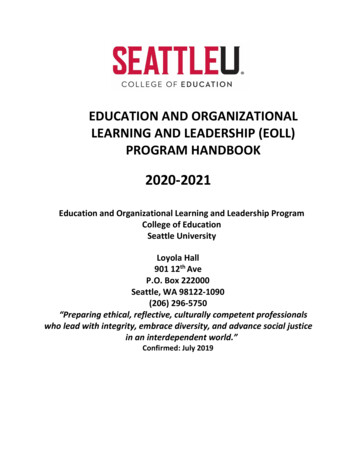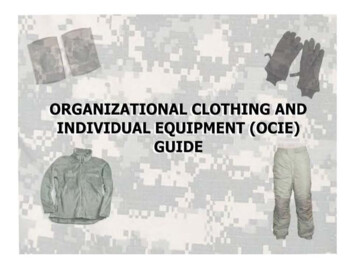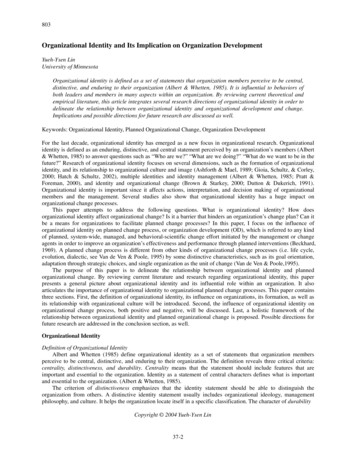
Transcription
803Organizational Identity and Its Implication on Organization DevelopmentYueh-Ysen LinUniversity of MinnesotaOrganizational identity is defined as a set of statements that organization members perceive to be central,distinctive, and enduring to their organization (Albert & Whetten, 1985). It is influential to behaviors ofboth leaders and members in many aspects within an organization. By reviewing current theoretical andempirical literature, this article integrates several research directions of organizational identity in order todelineate the relationship between organizational identity and organizational development and change.Implications and possible directions for future research are discussed as well.Keywords: Organizational Identity, Planned Organizational Change, Organization DevelopmentFor the last decade, organizational identity has emerged as a new focus in organizational research. Organizationalidentity is defined as an enduring, distinctive, and central statement perceived by an organization’s members (Albert& Whetten, 1985) to answer questions such as “Who are we?” “What are we doing?” “What do we want to be in thefuture?” Research of organizational identity focuses on several dimensions, such as the formation of organizationalidentity, and its relationship to organizational culture and image (Ashforth & Mael, 1989; Gioia, Schultz, & Corley,2000; Hatch & Schultz, 2002), multiple identities and identity management (Albert & Whetten, 1985; Pratt &Foreman, 2000), and identity and organizational change (Brown & Starkey, 2000; Dutton & Dukerich, 1991).Organizational identity is important since it affects actions, interpretation, and decision making of organizationalmembers and the management. Several studies also show that organizational identity has a huge impact onorganizational change processes.This paper attempts to address the following questions. What is organizational identity? How doesorganizational identity affect organizational change? Is it a barrier that hinders an organization’s change plan? Can itbe a means for organizations to facilitate planned change processes? In this paper, I focus on the influence oforganizational identity on planned change process, or organization development (OD), which is referred to any kindof planned, system-wide, managed, and behavioral-scientific change effort initiated by the management or changeagents in order to improve an organization’s effectiveness and performance through planned interventions (Beckhard,1969). A planned change process is different from other kinds of organizational change processes (i.e. life cycle,evolution, dialectic, see Van de Ven & Poole, 1995) by some distinctive characteristics, such as its goal orientation,adaptation through strategic choices, and single organization as the unit of change (Van de Ven & Poole,1995).The purpose of this paper is to delineate the relationship between organizational identity and plannedorganizational change. By reviewing current literature and research regarding organizational identity, this paperpresents a general picture about organizational identity and its influential role within an organization. It alsoarticulates the importance of organizational identity to organizational planned change processes. This paper containsthree sections. First, the definition of organizational identity, its influence on organizations, its formation, as well asits relationship with organizational culture will be introduced. Second, the influence of organizational identity onorganizational change process, both positive and negative, will be discussed. Last, a holistic framework of therelationship between organizational identity and planned organizational change is proposed. Possible directions forfuture research are addressed in the conclusion section, as well.Organizational IdentityDefinition of Organizational IdentityAlbert and Whetten (1985) define organizational identity as a set of statements that organization membersperceive to be central, distinctive, and enduring to their organization. The definition reveals three critical criteria:centrality, distinctiveness, and durability. Centrality means that the statement should include features that areimportant and essential to the organization. Identity as a statement of central characters defines what is importantand essential to the organization. (Albert & Whetten, 1985).The criterion of distinctiveness emphasizes that the identity statement should be able to distinguish theorganization from others. A distinctive identity statement usually includes organizational ideology, managementphilosophy, and culture. It helps the organization locate itself in a specific classification. The character of durabilityCopyright 2004 Yueh-Ysen Lin37-2
804emphasizes the enduring nature of organizational identity. It implies that organizational change is difficult to startbecause the loss of organizational identity will have strong impact on the organization (Albert & Whetten, 1985).Influence of Organizational IdentityAccording to the definition, an identity statement is collectively and cognitively held by organization membersto answer questions such as “Who are we?” “What business are we in?” and “What do we want to be?”Organizational identity influences both leaders and members within an organization. For organizational leaders,organizational identity is influential on their decision making activities within an organization. Typically, identityquestions surface and attract the management’s attention when they cannot find easier, more specific, and morequantifiable solutions regarding specific organizational issues (Albert & Whetten, 1985). By defining theorganization’s identity, organizational leaders establish a fundamental base that serves as the guide for them toengage in decision making activities (Albert & Whetten, 1985)Organizational members are affected by an organization’s identity as well. Since social identity theory suggeststhat individuals have the natural tendency to identify with social groups and define themselves with the connectionwith these groups (Pfeffer & Salancik, 1978), organizational members’ answers to identity questions have stronginfluences on their judgment of and identification with their organizations (Albert & Whetten, 1985). Thisidentification in turn affects the establishment and maintenance of members’ self-esteem (Humphrey & Brown,2002). Organizational identity provides organizational management and members with a key lens for theirinterpretation and sensemaking about occurring events for their organizational life (Dutton & Dukerich, 1991;Elsbach & Kramer, 1996). The results of member interpretation and sensemaking direct members’ behaviors andactions within the organization (Dutton & Dukerich, 1991).Formation of Organizational IdentityBased on the identity interaction model and individual identity theory (Cooley, 1922; Erickson, 1968; Goffman,1959; Mead, 1934), Albert and Whetten (1985) argue that interaction and comparison with other organizations arekeys to the formation of organizational identity. Similar to individual identity, the formation of organizationalidentity is a process of ordered interorganizational comparisons (Albert, 1977). During the processes, membersconstantly compare their own organization with target organizations and obtain evaluative information from otherparties which, in turn, affect members’ definition and identity of their own organization.Identity scholars hold different opinions regarding the relationship between organizational identity andorganizational culture. For example, Albert (1998) argues that a particular organizational culture may, or may not, bepart of organizational identity, depending upon the relevance and importance of culture to the identity question. Yet,some researchers clearly propose a dynamic relationship between identity and culture to explain the formation ofidentity (Ashforth & Mael, 1989; Gioia et al., 2000; Hatch & Schultz, 2002). For instance, Ashforth and Mael (1989)argue that the important values in organizational culture are critical determinants to the psychological process ofidentity formation. Only when individuals identify with the central, distinctive characteristics of the culture will theybe willing to attach to a social group. This psychological process of attachment, in turn, reinforces individualidentity as well as the solidity of organizational identity (Ashforth & Mael, 1989).Hatch and Schultz (2002) propose another dynamic model to illustrate the relationship between organizationalidentity, culture, and image (see figure 1). According to the model, members express their understandings of theirorganizational culture through organizational identity, which in turn, affects the perception of others outside theorganization about the organization. The outsiders’ perception, or organizational image, in turn, affects theorganizational identity, which again is reflected in the central elements of the organizational culture.Despite the dynamic arguments of the formation process of organizational identity challenges the criterion thatdurability, it is considered as a better condition for organizational change, since it provides the organization with theflexibility and adaptability to respond to the environmental demands. The influence of identity on organizationalchange will be detailed discussed in the following section.Figure 1 Hatch & Schultz’s (2002) Organizational Identity Dynamics ModelIdentity mirrors the images of othersIdentity expresses cultural understandingCultureReflecting embeds identity in cultureIdentityImageExpressed identity leavesimpressions on others37-2
805Organizational Identity and Resistance to Planned Organizational ChangeSince organizational identity represents an ostensible set of central, enduring, and distinctive statements with whichmembers define their organization, it provides an important psychological anchor for members in time of upheaval(Gustafson & Reger, 1995). Organizational identity, however, is also a possible source of resistance to change(Dutton & Dukerich, 1991; Gustafson & Reger, 1995). For example, from a psychodynamic perspective, Brown andStarkey (2000) examined the relationship between organizational identity and organizational learning. Analogous toindividual identity theory, organizational members have the tendency to maintain their collective self-esteem andidentity by not questioning their existing self-concept (Brown & Starkey, 2000). Learning and receiving newinformation are likely to evoke organizational members’ feelings of anxiety and trigger some kind of defensemechanisms. This is particularly true when the new self-concept is inconsistent with the existing beliefs andself-image (Brown & Starkey, 2000). As a result, these defense mechanisms hinder organizational learning byinfluencing how members of the organization search, interpret, use, and store new information.From a more concrete viewpoint, organizational identity influences management and members within anorganization in several ways; from organizational leaders’ actions and decision making regarding change initiatives,to members’ interpretation of organizational events and actions. Moreover, organizational identity affects members’comparison processes and evaluation of strategies and actions as well. These influences are discussed in thefollowing sections.Organizational Identity as Action GuidelinesOrganizational identity serves as guidelines leading managers’ actions and decision making in relation toplanned change process. For example, Fox-Wolfgramm, Boal, and Hunt (1998) conducted a longitudinal study toexamine banks’ adaptation processes to a new governmental regulation, which had a strong impact on the banksstrategies and operations. The research focused on two types of banks, one termed a prospector and the other adefender (Miles & Snow, 1978). Broadly speaking, a prospector organization is more dynamic, more decentralized,but less formalized and specialized than a defender. Prospector organizations usually have broader product lines,tend to focus on innovation and emerging market opportunities, and emphasize creativity over efficiency. On thecontrary, defender organizations are characterized as less dynamic and place less emphasis on innovation. Defenderorganizations also tend to focus on efficiency over creativity and innovation (Miles & Snow, 1978).Given the different characters of the two types of bank organizations, Fox-Golfgramm et al. (1998) expecteddifferent responses between the two banks to the new regulation. Since the prospector bank has features of flexibilityand dynamics, and is open to environmental change, it is expected to adjust itself faster without needing muchexternal stress and confronting much internal resistance. On the other hand, the defender bank was expected to beless effective and to encounter more resistance in responding to necessary change during the adaptation process,given its more formalized and less dynamic features.Surprisingly, the results showed that both banks encountered resistance, though for different reasons. For thedefender bank, the top management resisted in taking action because they felt the new regulation did not fit withtheir “hometown identity”. The prospector bank felt that they had already met the requirement. This study supportsGioia and Thomas’s (1996) conclusion, which argues that, under conditions of change, top management teammembers’ perceptions of organizational identity play a critical role in their sensemaking process and issueinterpretation.Organizational Identity as an Interpretative LensIn addition to the influence on management’s decision making and sensemaking processes, the second waythat organizational identity affects organization members is its provision of a lens through which members interpretevents occurring within the organization. In a case study of the New York Port Authority’s dealing with thehomelessness problem, Dutton and Dukerich (1991) examined how organizational identity and image affects itsmembers in making sense and interpreting their organization’s responses to a nontraditional and emotional strategicissue. They found that the importance of organizational identity is shown in three dimensions: issue interpretation,emotion, and action.In the dimension of issue interpretation, organizational identity serves as a reference point for organizationmembers to assess the importance of an issue which, in turn, becomes predictors of members’ willingness to investin the issue. If the scope of the issue continuously expands over time, or the issue threatens the core components ofthe organizational identity, or the organization takes actions that seemed to members as inconsistent with theiridentity, organization members tend to “judge the issue as more important and the organization as more committedto it” (Dutton & Dukerich, 1991, p.545). In other words, organizational identity defines to what extent the issue islikely to threaten the organization and helps the organization to resolve the issue by transforming it into anopportunity (Jackson & Dutton, 1988). Additionally, organizational identity also affects the meanings that members37-2
806give to an issue, which in turn, leads to different solutions for the issue (Dutton & Dukerich, 1991).Beside issue interpretation, organizational identity also provides directions for explaining members’ emotionalexpression about an issue. That is, members are expected to have positive emotions when actions taken arecongruent with their organizational identity, while negative emotions is more likely to be generated when the actionsare inconsistent with their identity. Moreover, identity also affects the pattern of organizational actions through itsserving as guidelines for members to find acceptable solutions, to understand how actions are shaped, and toevaluate the success of actions (Dutton & Dukerich, 1991).Organizational Identity as Cognitive SchemaIn addition to serving as guidelines for management actions and a lens for member interpretation,organizational identity serves as a cognitive schema composed of beliefs and assumptions of organizationalprocesses (Fiol & Huff, 1992; Reger et al., 1994). This schema influences how members encode and store newinformation, as well as how they draw inference from events with ambiguous or missing information (Reger et al.,1994). Since organization members use the cognitive schema to integrate prior and new knowledge, they tend tofocus on new information consistent with their existing schema (Fiske & Neuberg, 1990), and ignore incongruentinformation. The tendency of focusing on congruent information is called “cognitive inertia,” referring to the“resistance to changes that deviate from existing schemas or frames” (Reger, et al., 1994, p566).Reger et al. (1994) use the concept of cognitive inertia to explain the high failure rate of total qualitymanagement (TQM). Traditionally, a successful TQM implementation within an organization focuses on a“paradigm shift,” requiring a total, radical change in members’ basic philosophy in the organization (Dobyns &Crawford-Mason, 1991; Munroe-Faure & Munroe-Faure, 1992). This kind of change intervention can only beunderstood and interpreted by members using their existing schema; yet, it is very likely that the new concepts of ofsuch intervention are not part of members’ current cognitive schema. Thus, the radical change challenges members’assumptions and the identity of the organization and, in turn, results in members’ uncomfortable feelings andresistance to the intervention. This resistance makes large-scale change such as TQM difficult to achieve (Reger etal., 1994). This argument again affirms the important influence of organizational identity on organizational changeinterventions.Organizational Identity as Comparison ReferenceOrganizational identity not only affects managerial actions, as well as member interpretations and actions, butalso serves as a reference point for comparison. As mentioned in the previous section, organizational memberscompare their organizational identity with actions taken by the management to judge the legitimacy of the action(Dutton & Dukerich, 1991). Likewise, members also compare their current identity with the envisionedorganizational identity. Envisioned organizational identity, refers to an ideal or desired identity that represents whatthe management want the organization to be in the future (Reger et al., 1994). This envisioned identity can bereinforced through the creation of visions by organization leaders. Fox-Golfgramm et al. (1998) argue that thecongruence between the current and envisioned identity has a strong influence on the permanent success or not of achange intervention. That is, members’ resistance to a change intervention is more likely to occur if inconsistencyexists between the current and envisioned identity (Fox-Golfgramm at al., 1998).In addition to the envisioned identity, organizational image is another target for members to make comparisonwith. As defined previously, organizational images have to do with how organizational members believe outsidersthink about their organization (Dutton & Dukerich, 1991). Thus, members’ perception of organizational imagesaffects their own view of themselves as well as of the organization. On the one hand, when the perceived image andidentity are consistent, members tend to accept the status quo and, thus, no change will occur. On the other hand,when incongruence exists, changes may, or may not, occur because organizational members need to make furtherjudgment to see if the discrepancy is important and worthy their efforts on change (Gioia et al., 2000).The external pressure for change provides organizational members yet another target to compare with theiridentity and image (Dutton & Dukerich, 1991; Fox-Golfgramm et al., 1998). More specifically, when the pressurefor
individual identity theory, organizational members have the tendency to maintain their collective self-esteem and identity by not questioning their existing self-concept (Brown & Starkey, 2000). Learning and receiving new information are likely to evoke organizational members’ feelings of anxiety and trigger some kind of defense mechanisms.File Size: 208KBPage Count: 8

